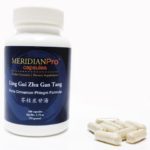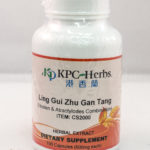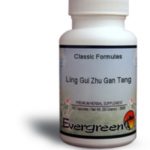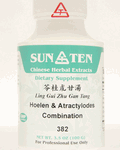Disclaimer For educational purposes only. Do not use as medical advice
AboutChinese MedicineCaution/Notes
| Health Benefits |
| For: |
| Atributes: |
| Category: Dispel Damp Cold, Cold Phlegm ⌕ |
| Source: Shang Han Lun |
| Actions: Warms and transforms phlegm and congested fluids, tonify Spleen, and resolves dampness
[Song] |
| Diagnosis |
| Tongue: pale, swollen, white, slippery coat Pulse: wiry, slippery, or deep, soggy Other: |
| Patterns: Middle Jiao Deficiency Cold, Middle Jiao Yang Deficiency, Phlegm Water Retention |
| Indications: Phlegm and water retention with Middle Jiao yang deficiency. Spleen fails to transform dampness. Chest and hypochondria fullness, shortness of breath, cough, palpitation, dizziness.
[Song] • Lung Damp Phlegm/ Phlegm Fluid = Tan Yin = Rheum (gurgling sound). Cough with copious sputum fullness in the chest and hypochondrim, palpitations, vertigo.
T: Pale, swollen with white slippery coat. P: wiry, soggy [Kim]
|
| Contraindications: Cough with sticky phlegm from water retention heat [Song] |
| Description |
| Name Variations:Ling Gui Zhu Gan Tang, 苓桂术甘汤, Poria, Cinnamon Twig, Atractylodis Macrocephalae, and Licorice Decoction, |
| Herb List: Fu Ling(K) • Gui Zhi(M) • Bai Zhu(A) • Gan Cao(E) |
| Commentary: This is the basic formula for cold dampness. Fu Ling drains dampness from Middle Jiao all the way down and strengthens Spleen. Gui Zhi promotes yang Qi transformation and indirectly transforming water/dampness. Also the Gui Zhi/Fu Ling dui yao often are combined to promote yang Qi transformation and descending rebellious Qi. [Song] |
| Related Formulas: |
| Herbs |
Cat/Dosage |
Actions |
Attributes |
| Fu Ling • Poria Mushroom • 茯苓 ♠ |
Drain Dampness |
Dry dampness • Tonify spleen • Calm spirit • Relief edema • Detox food poisoning • Promote urination Dao Di: Yun Nan |
Diuretic • Antibacterial • Anti-inflammatory • Anti-allergic • Hypoglycemic • Antacid • Sedative • Immunity booster |
| Gui Zhi • Cinnamon Twig • 桂枝 ♥ |
Release Exterior Wind Cold |
Activate yang qi, warm yang, open channels, expel Wind Cold from muscle layer • warm Middle Jiao • regulate Wei Qi • improve circulation • relieve pain • thin mucus • treat chest BiPAIRS with Shao Yao and Fu Ling |
diuretic, anticoagulant, vasodilation, diaphoretic, antipyretic, emmenagogue, antiparasitic, cardiotonic, antibiotic, hypoglycemic, analgesic, anti-inflammatory, antioxidant, sedative |
| Bai Zhu • White Atractylodes Root • 白术 ♣ |
Tonify Qi |
Tonify Spleen Qi • Stop sweating • Calms fetus • Dry dampness • Stabilize exterior • Stop sweating Dao Di: Zhe Jiang |
Anti-inflammatory • Hepatoprotective • Immunity Booster • Hypoglycemic • Antibaterial |
| Gan Cao • Licorice Root • 甘草 ♦ |
Tonify Qi |
Tonify Spleen Qi • Tonify Heart qi • Clear heat • Resolve toxicity • Stop cough • Dispel phlegm • Lubricate lungs • Stop wheezing • Reduce spasm • Relieve pain • Harmonize other herb effectsEnters all 12 channels, often serve as envoy in a formula. |
Hypoglycemic • Antiarrhythmic • Expectorant • Antidiarrheal • Antiulcer • Hepatoprotective • Immunostimulant • Antitussive • Antiviral • Detox • Demulcent • Anti-inflammatory • Laxative • Emmenagogue • Antimicrobial • Spasmolytic • Corticosteroidal |
| ♠ King/Chief ♥ Minister/Deputy ♣ Assistant ♦ Envoy |
| Directions: |
| Modifications |
For |
| + Ban Xia + Chen Pi |
Lots of phlegm 31 |
| + Zhi Shi + Sheng Jiang |
ADistension in epigastria with water sound 31 |
|
|
|
|
| Caution |
|
ALERT: Contraindications of each herb - use with caution under these conditions:
Fu Ling: Foods: Vinegar, pickled food
Gui Zhi: Pregnancy, Liver Wind, hyperactive Yang from Yin xu, Wind Heat, blood heat, heavy menses, measles, open skin sores
Bai Zhu: Autoimmune disorder • Yin deficiency with heat • Dehydration • Foods: black carp, Chinese cabbage, peach, plum and coriander
Gan Cao: High blood pressure • Low potassium • Seaweed • Medications: Gan Cao can interact with various medication. See Pharma Interaction section. |





0 Comments